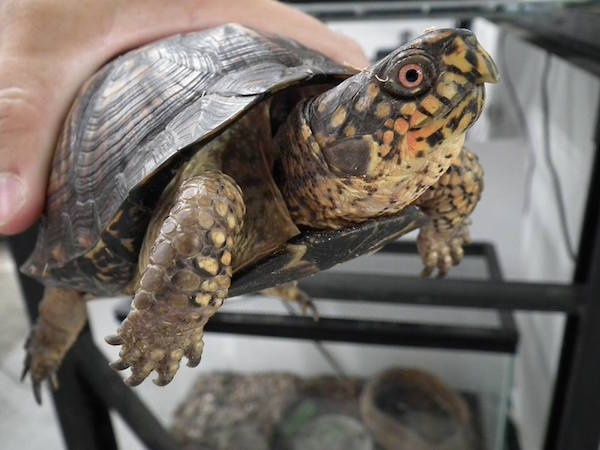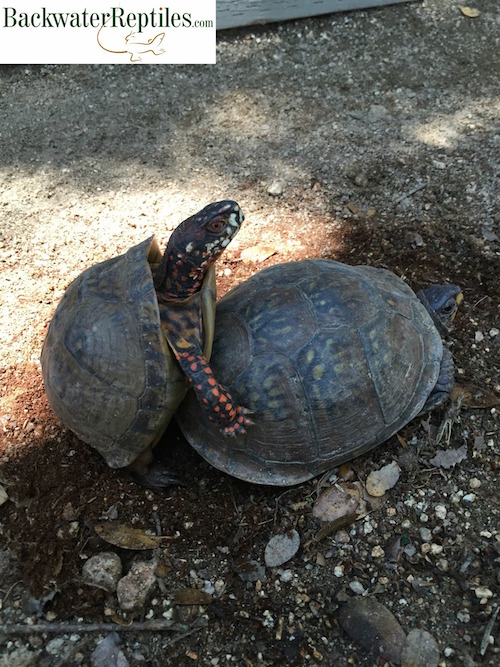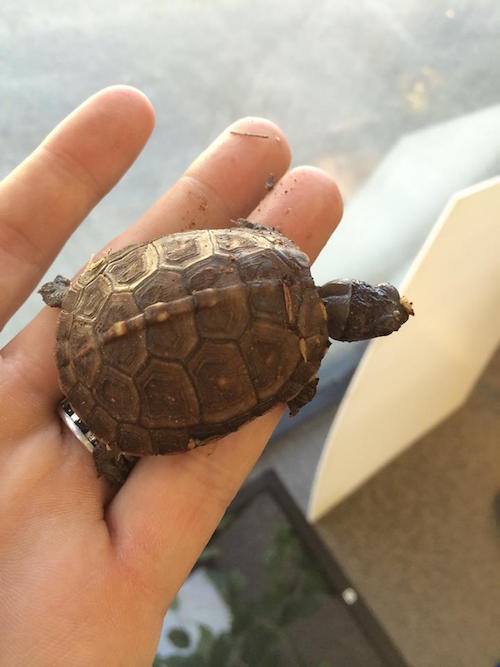Breeding Box turtles isn’t all that tough, and we’ll explain how within the below article. This week at Backwater Reptiles headquarters, we witnessed a pair of our Three Toed Box Turtles (Terrapene carolina triunguis) mating, something we have seen many times here in our outdoor turtle pens. We figured since Spring/Summer is the time of year for reproductive behavior to occur, it would be a great opportunity for us to share our knowledge on how to breed these wonderful turtles.
As we all know, the first thing you need to breed any animal is a male and female of the species. While Three Toed Box Turtles are not exactly sexually dimorphic, there are some tricks you can use to identify whether or not you’ve got the correct genders to produce babies.
Males of the species tend to be more brilliantly-colored than the females, exhibiting orange, red, or white on their faces with red eyes, while females are duller in color and usually have green eyes. Males are generally smaller than females but do have larger, longer tails and rear nails. The male has a concave plastron (underside) so that he can conform better to the shape of the female’s shell as he mounts her, whereas the plastron of the females is flat.

Once you have sexed your turtles, it is ideal to house them outdoors as it allows them to have a natural cycle to follow for breeding. If they are housed outside, after the cooler winter/fall months have passed, the females will emerge from hibernation and begin looking for a suitable area to nest and lay eggs. It is best if you create your own “suggested” areas for the female to lay her eggs as they will be buried and you want to be able to know where she has deposited them. Suggested areas are warm and moist and will have soft soil for digging.
http://https://youtu.be/hkNhj8rse10
Breeding will have occurred the previous spring/summer. Males will circle the female, butting up against her and sometimes biting her. Sometimes the males will also inflate their necks in order to promote receptivity in the female. Once the courtship ritual has been completed, the male will mount the female and she will lower her plastron letting him hook his nails beneath her carapace. She will then close up her carapace on his nails so he doesn’t slide off during the actual copulation, which can take up to an hour. It should also be noted that females can retain this sperm and lay viable eggs for up to four years after breeding, so she may not lay eggs for several years.

Box Turtle Eggs
Eggs will take about 70 days to hatch and should be kept between 84 and 88 degrees Fahrenheit. If you transfer your eggs from outdoors to inside so you can keep a better watch on them, do so carefully. You want to make sure the eggs are not shifted, turned over, or jostled. It’s best to make a pencil or marker line on the top so that as you gently move them to a new container, you won’t accidentally turn them. Store the eggs in a temperature controlled room in moist vermiculite or perlite.
Once the babies start emerging from the eggs, they should not be allowed to live outside right away as they require more structured conditions as they grow. The newborns must have access to water at all times as well as a place where they can completely get out of water (i.e. a patch of dry land). They will eat appropriately-sized dusted and gut-loaded insects, plant matter, and pre-made turtle chow. It’s a personal choice what to feed your baby box turtle – just make sure that it’s varied and frequent as growing reptiles (like growing humans) need to get lots of vitamins, protein, and nutrients.

We don’t currently have any hatchling Three Toed Box Turtles available (although we will in a few weeks once the eggs start hatching), but we do have adult Three Toed Box Turtles for sale that are around three to five inches in length – just the right size for if you want to start your own breeding project.


